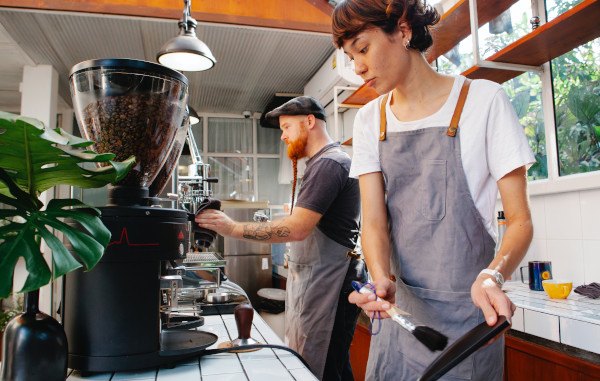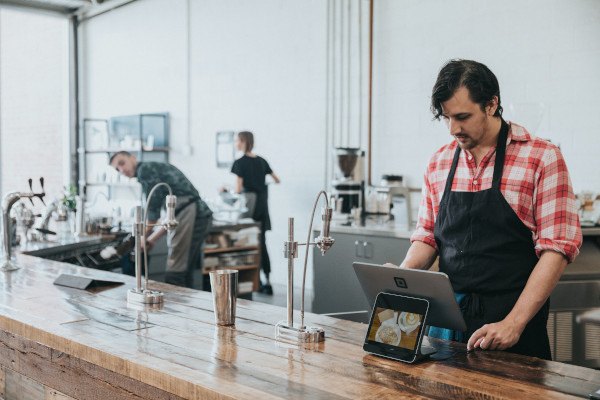How To Start A Coffee Shop Business
The coffee industry is experiencing a growth never seen before as an increasing number of young and old generations alike have become interested in not just coffee but high-quality gourmet coffee only a coffee shop can provide. As a result of this growing interest and demand in coffee, now is a great time to consider opening a coffee shop or cafe. If you’ve been going back and forth about finally building the coffee shop business of your dreams but don’t quite know where to start, we have just what you need in this article!
Starting a coffee shop business is a great way to earn a living in a fascinating, fast-paced industry while actively participating and contributing to your local community. Lucky for you, this guide will walk you through the necessary steps to make your coffee goals a reality. From formulating a business plan, strategies to scale, and, most importantly, choosing a POS system to streamline your business processes, we’ve got everything you need to know right here!
Read on to find out the steps you’ll need to follow to kick start this business successfully and how a trusted coffee shop POS can significantly help you in this venture!
Step 1: Research and Start With A Coffee Shop Business Plan

A strong and feasible business plan for your coffee shop is your first step toward building a profitable company. Your business plan should have enough structure to give you great footing to start but enough flexibility to make way for growth and scaling, as it is a pretty fluid and constantly changing document.
You’ll also want to determine the type of coffee shop business you’d like to open. Do you want a traditional coffee shop, a coffee roaster, a mobile coffee truck, or other types of businesses? After considering your business setup, you must consider the starting cost. When drafting the projected costs to start your business, it’s best to go as detailed as possible (utility, rent, employees, marketing, equipment, etc.) and what essential items should be part of your budget.
Another critical part of this planning stage is researching your market and competitors and finding the right connections in the industry. Networking in the coffee industry will always get you further ahead than some Google searches.
Step 2: Determine Your Target Market and Define Your Brand

The next step in starting your coffee shop business is formulating and developing your marketing and brand strategies. Two parties make your business successful: your customers and yourself. Your customers should be the heart of your coffee shop marketing strategy because your business aims to cater to different types of customers. You can ask yourself what they need and desire from your coffee shop.
A great way to get to know your customers well is to start categorizing them into specific target markets and formulate a branding and marketing strategy for each group. Do you operate your business near a university? Students may want a place to study or socialize over a cup of coffee and some sweets. Do you operate within the vicinity of a residential area? Parents might want to stop for a quick coffee and grub in the morning.
As you think of these people as you develop your coffee shop marketing strategy, please think of the best and most effective way to reach out to them. Successful coffee shop owners highlighted the importance of using online platforms for promotion such as online marketplaces and social media as one of their most effective marketing strategies to reach out to their target market.
Defining Your Brand
In developing a brand strategy, you have to start thinking of yourself. What are your brand's identity, values and business objectives? How can your unique story give value to your brand and your customers?
Your equipment also plays a massive part in creating your brand and establishing a good impression. For this, you would like to employ efficient and innovative tools to streamline your business processes and improve your customers’ overall experience with your brand.
Step 3: Form the Business And Launch

This is the part where you slowly but surely make your way into a real, actual running business, and in this step, choosing a business location plays a huge part. Learn how to pick a great location by learning from the success stories of professionals. One of the best things you can do is to choose a convenient spot where the surroundings bring in a lot of traffic. Just as important as picking a good location is ensuring that your space has everything it needs to run your business, like the right amount of water supply and electrical power.
You'll learn that you must put in significant work to get a turnout for your opening day. Hiring and training the right kind of staff is part of making that opening day a success.
You want your customers to experience the culture of your business right away, and the staff you hire greatly contribute to creating that atmosphere. Remember that any skill can be taught and learned, but personalities are what will make your business thrive. For this, you can learn what coffee shop entrepreneurs think are the best traits to look for in a new hire.
Step 4: Take Care Of Day-to-Day Operations

You may have imagined what it looks like to run a coffee business everyday. And yes, since it is one of the busiest industries that never runs out of demand, it includes many work hours. To make your coffee shop business popular and considered a local hub, you must be ready to commit time and effort.
This is why all technology and equipment you will use for your business should be in tip-top shape, smart and reliable so that they can not only save you time and money by streamlining your processes but also positively impact the kind of experience your customers will have with your business.
Cash registers are considered a thing of the past. Read our guide on coffee shops' best Point-of-Sale (POS) systems. The most successful coffee shops have smart POS systems that make it easy to track inventory and sales even from the comfort of your home. Read on to learn various factors to consider while choosing the best POS systems for your coffee shop business and how it can save you time from doing basic sales tasks so you can focus on other, more important business duties.
Step 5: Think About How To Scale

This is the final part of this guide, which deals with what happens after establishing an excellent footing in running your business. When business is doing great, and everything is up and running, it may be tempting to take your business in a new direction or up it to another level. Before you think of growing, determine how well your business is performing currently. Do things feel right? Do you have a high-quality team with you?
It's best to make significant business decisions based on data and analytics, not feelings or moods. For this, a POS with smart sales analytics in their Back Office is exactly what you need. In your POS Back Office, all sale processes and inventory movements are recorded accurately in real time!
After thinking this over, you could expand your product offerings, avail more space, or even grow into a franchise. But try not to take on too much at once. It all boils down to what you want your business to be.
It's still best to stay consistent with your original purpose and brand. Besides that, you need to consider the future and what your cash flow will be like down the road. Financial changes are likely, and you don’t want to be caught off guard.
4 Must-Have Coffee Shop POS Features
The best and most reliable POS systems allow coffee shops and cafe owners to have efficient and streamlined operations that will ultimately impact their bottom line positively. While brewing, your coffee shop technology should carry you through the morning rush and beyond. The right POS features can help coffee shops stand out from the crowd and keep customers returning while improving your operational efficiency and your cafe’s margins.
Here are four coffee shop POS features to prioritize as you choose for a POS technology that will help you grow your coffee shop business.
1. Customer Facing Display
Coffee shops can use POS terminals with customer facing displays or Customer Display System (CDS) to move customers through the line as quickly as possible. As the sale is ongoing, a CDS will display price information to your customers at the time of purchase.
CDS is often placed at the counter in front of the customer so they can view the details about the items that are added to their receipt. Having a CDS is a modern way to give clients more control over their purchases.
Those who wish to receive an e-receipt can quickly enter their email in CDS. In the case of cash payments, CDS also displays the change.This will help to reduce the time it takes to complete transactions and allow you to serve more guests at peak hours.
2. In-Depth Reporting
As mentioned above, the POS should also allow you to segment the data based on shared characteristics among customers, compare data over time, and create lists that can be used to fuel powerful targeted marketing campaigns.
Will Goodwin, Owner at Spoken Cafe, said, "You need data to help improve your business. I look at our sales compared to last year's sales almost daily."
The Back Office of your POS is an online-based tool that works in connection with your POS. It gives you sales reports to make a complete view of your business and allows you to adjust settings and manage your accounts thoroughly via a browser on any device. It is a powerful sales data and analytics tool as it provides a wide variety of reports and sales analytics so you can analyze your sales by different parameters, such as time, stores, employees, payment types, etc. In the Back Office, you can manage your inventory, employees, and customers, set the features necessary for your business, bulk import/export a list of items and customers, and export sales reports.
3. Easy Menu Management
Let’s face it: Some customers’ coffee orders can get outrageous. Your baristas should be able to make that decaf latte extra hot with 10% milk, a shot of cappuccino espresso, and a cherry on top with modifiers that are easy to add and easy to customize.
If your coffee shop has seasonal menus or frequently offers unique add-ons or modifiers, you need a POS system that will make it breezy to update the menu. With a cloud-based POS system, cafes can make changes to their menu in real-time at the coffee shop or remotely with any device with internet access.
In addition, with some cloud-based systems, since inventory is updated in real-time too, coffee shops can easily mark items as out of stock so they can no longer be available on the POS system or set a countdown on items with a limited available quantity.
4. Mobile Loyalty Program
How can you identify your regular customers with so many guests moving quickly through the line and in and out of your coffee shop? Loyalty programs are a great way to show your customers how much you appreciate their business and encourage future visits.Even the simplest loyalty programs for coffee shops built-in on your POS can motivate customers to make recurring purchases. They create the opportunity for you to take customer relationships to greater depths and reward their visits with bonus points.
With a mobile loyalty program in your POS,your customers will be happy to know they can now collect bonus points at their favorite small business.
Exploring Coffee Shop POS

Every coffee shop needs a POS system.The best POS system for your coffee shop depends on your business needs. For example, you may be mostly looking for a free coffee POS, a POS that can function without reliable internet, or a system that includes cloud and mobile features. Whatever your specific feature needs, you should be able to find them a modern POS.
Edited by Chooli
-
 1
1
-
 1
1



0 Comments
Recommended Comments
There are no comments to display.
Please sign in to comment
You will be able to leave a comment after signing in
Sign In Now